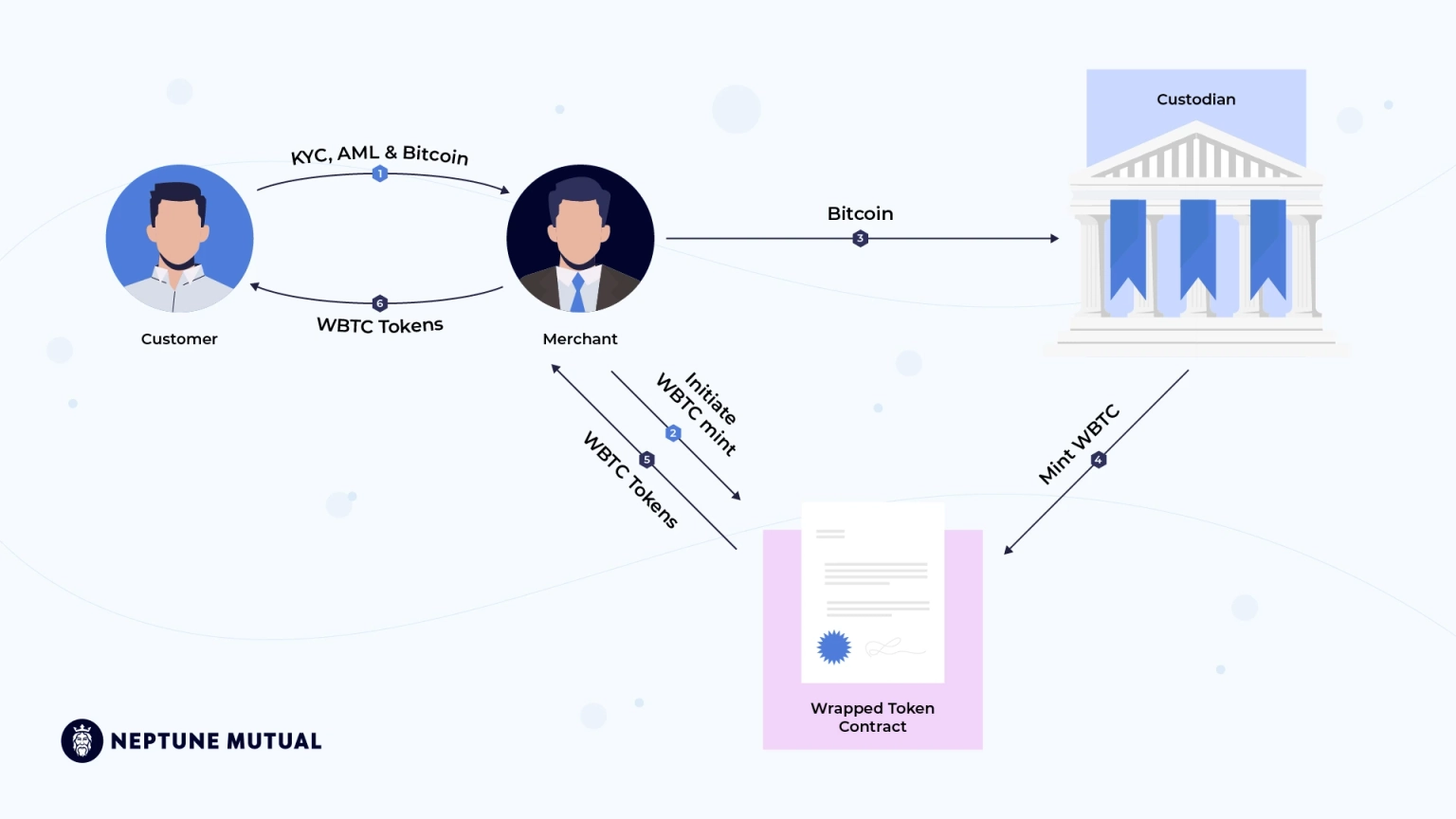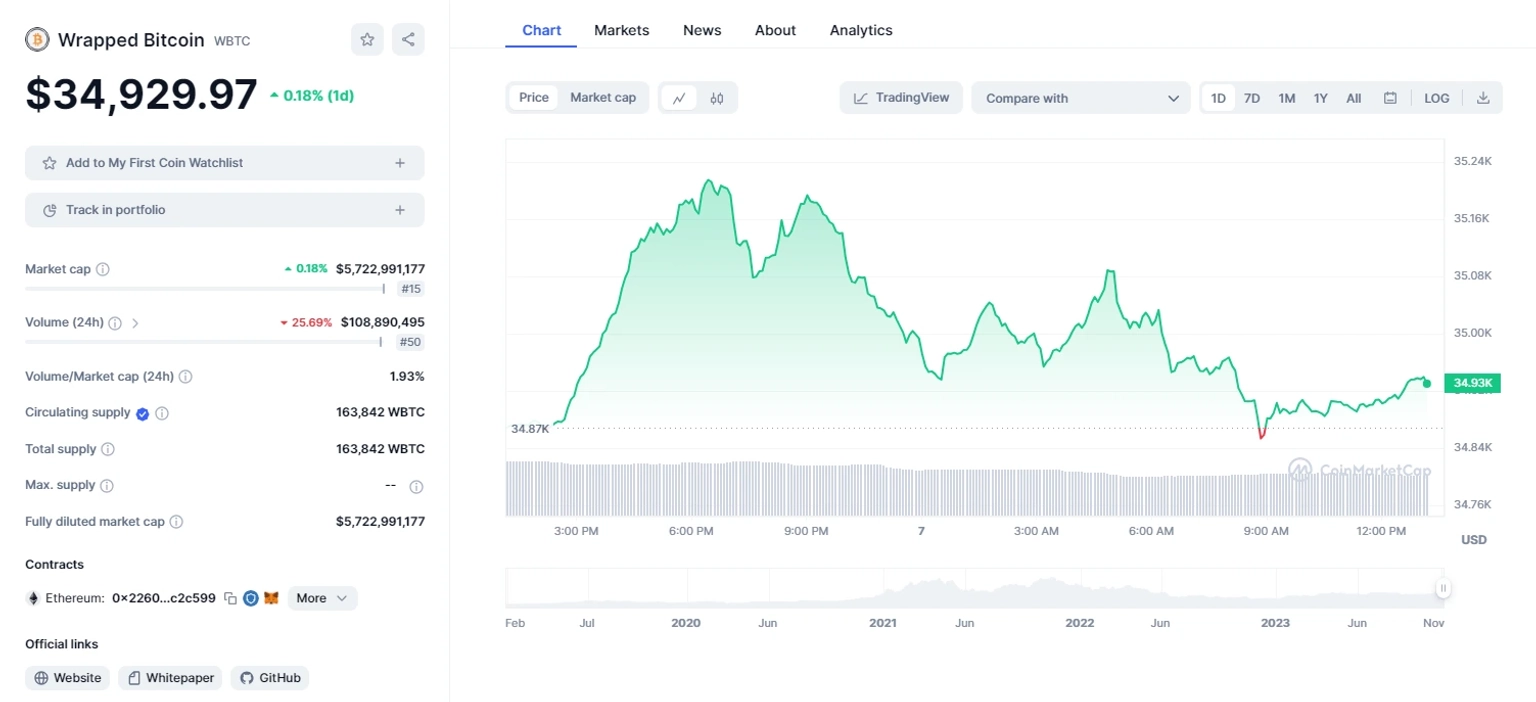
Collaboration between Neptune Mutual and SushiSwap
Explore Neptune Mutual's ongoing collaboration with SushiSwap offering several benefits.
Youtube Video
Playing the video that you've selected below in an iframe

Understand what wrapped bitcoins are including its workings, benefits, and challenges.
In the cryptocurrency world, two giant networks, Bitcoin and Ethereum, always stand out. Bitcoin has long been revered as the standard of digital currencies and the pioneer of blockchain technology, providing a robust decentralized ledger. Ethereum, on the other hand, revolutionized the space with its smart contract capabilities, paving the way for decentralized finance (DeFi) applications.
However, a notable gap existed: Bitcoin's isolated network couldn't interact directly with Ethereum's smart contracts and DeFi. This is where Wrapped Bitcoin (WBTC) steps in, a groundbreaking innovation melding the strengths of both worlds.
Wrapped Bitcoin (WBTC) is not just another token in the crypto universe. It's a bridge and a connector that allow the value and stability of Bitcoin to flow freely into Ethereum's dynamic ecosystem of smart contracts and dApps.
In this article, we'll delve into the essence of WBTC, its benefits, how it functions, and its transformative impact on the crypto landscape.
Wrapped Bitcoin, or WBTC, is a tokenized version of Bitcoin. It's an ERC-20 token that represents the value of underlying Bitcoin on the Ethereum blockchain. To put it simply, wrapped Bitcoins allow utilizing BTC and other Bitcoin assets on a non-native blockchain network, i.e., Ethereum. This ingenious solution offers the best of both worlds: the market dominance and trust of Bitcoin coupled with the flexibility and functional richness of Ethereum.
Launched in 2019, WBTC has been a pivotal innovation in the blockchain and Web3 ecosystems. It extends the utility of Bitcoin beyond its traditional domain, enabling Bitcoin holders to venture into the vibrant world of Ethereum's DeFi and dApps without giving up their Bitcoin holdings. This seamless integration broadens the horizons for both Bitcoin enthusiasts and Ethereum advocates.
2) Wrapped Bitcoin (WBTC) is the first ERC20 token backed 1:1 to Bitcoin. It’s aiming to bring the representative and new use-cases of Bitcoin into Ethereum blockchain. pic.twitter.com/NtaKbZvsdm
— WBTC (@WrappedBTC) May 23, 2019
Let’s see some benefits of WBTC.
One of the most significant advantages of WBTC is its ability to inject Bitcoin's vast liquidity into Ethereum's DeFi ecosystem. This liquidity is vital for the healthy functioning of various financial applications, from lending platforms to decentralized exchanges.
WBTC leverages Ethereum's faster block times, leading to quicker transaction confirmations compared to traditional Bitcoin transactions. This speed is a game-changer for users accustomed to the slower pace of Bitcoin's network.
WBTC stands as a testament to the growing interoperability in the crypto world. It enables the smooth transfer of value between the Bitcoin and Ethereum networks, a feature that was previously unattainable.

The process of transforming Bitcoin into WBTC is fascinating and involves several key players: users, custodians, merchants, and WBTC DAO members.
The WBTC token is created when users request it in exchange for their BTC. Users pay the amount in BTC for the WBTC they want and some additional minting fees. They receive an equivalent amount of WBTC in return while maintaining the value of Bitcoin to WBTC at a 1:1 ratio.
Merchants are the entities that facilitate the exchange process and carry out regulatory requirements like KYC (Know Your Customer) and AML (Anti-Money Laundering) on the users. Merchants are the intermediaries between users and custodians who receive the bitcoin amount from users before sending it to custodians.
Custodians are trusted entities responsible for holding the original Bitcoin and issuing the corresponding WBTC. Their role is crucial in maintaining the integrity and trust of the WBTC system.
When Bitcoin is converted to WBTC, new WBTC tokens are minted to reflect the added value on the Ethereum blockchain. Conversely, when WBTC is converted back to Bitcoin, the equivalent WBTC tokens are burned, ensuring the total supply remains consistent.
Members of the WBTC DAO are the holders of the keys to a multi-signature contract. The multi-signature contract is useful in facilitating contract adjustment and the addition and removal of merchants and custodians.
Despite its many benefits, WBTC does face some challenges and concerns:
The involvement of custodians in the WBTC process introduces an element of centralization. Since custodians hold the actual Bitcoin, there's an inherent trust factor at play. This setup contrasts with the decentralized ethos that many in the cryptocurrency community value.
Wrapped Bitcoin must navigate complex regulatory waters. The users requesting WBTC tokens will have to comply with the KYC and AML procedures. Though it’s crucial for legitimacy and security, it might not align with the original philosophy of cryptocurrency, which prioritizes anonymity and freedom from traditional financial systems.
The integration of Bitcoin into Ethereum's ecosystem through WBTC creates a new dynamic between these two major cryptocurrencies. It's vital to monitor how this impacts the market, especially considering the vast differences in their respective communities and use cases.
While WBTC brings Bitcoin's value to Ethereum, it’s distinct from native Ethereum tokens or other cryptocurrencies. Its unique position as a bridge between two major blockchains sets it apart.
The concept of wrapped cryptocurrency has seen significant adoption since its inception. It's useful in providing Bitcoin holders with access to Ethereum's expansive ecosystem without needing to liquidate their Bitcoin holdings. It’s utilized across various DeFi platforms, including MakerDAO, Compound, and AAVE, for lending and borrowing. It's also used in liquidity pools on Uniswap and Balancer, enabling users to earn interest, participate in yield farming, and engage in margin trading via applications like Fulcrum.
As of November 2023, over 163,700 WBTC tokens are in circulation and has a market capitalization of over $5.72 billion as per CoinMarketCap.

Wrapped Bitcoin Market Capitalization of over $5.72 billion; source: CoinMarketCap; Date: November 7, 2023
However, challenges such as regulatory shifts, the evolving landscape of blockchain technology, and competition from other wrapped assets or interoperability solutions could impact WBTC's trajectory. To maintain its relevance and utility, WBTC will need to adapt to these changing circumstances. Innovations in blockchain interoperability, improvements in the decentralization of the WBTC process, and collaborations within the broader crypto ecosystem could all play a role in its future success.
Wrapped Bitcoin represents a significant milestone with its unique ability to bring together the liquidity and familiarity of Bitcoin with the flexibility and innovation of Ethereum's DeFi ecosystem. While WBTC marks a significant advancement in the DeFi ecosystem, it is not immune to threats and vulnerabilities.
Wrapped Bitcoin (WBTC) is not without security risks, primarily due to its dependency on custodians. Although WBTC operates on Ethereum, the safety of these tokens depends on the custodians holding the actual Bitcoin. If these custodians act dishonestly, releasing the Bitcoins to others, the WBTC tokens would be worthless.
This reliance on a centralized entity necessitates a high degree of trust from users, who must ensure these organizations provide sufficient guarantees. While decentralized, smart-contract-managed bridges offer an alternative, bridges do not have a good track record of smart contract security and again represent a significant risk. In either case, mitigating custodian risk or smart contract risk with DeFi insurance wherever covers are available is certainly worth consideration.
Neptune Mutual is a DeFi insurance protocol aimed at protecting cryptocurrencies like WBTC invested in different protocols. With DeFi insurance, token holders can purchase coverage for their funds and receive payouts in case hacks or exploits occur that trigger certain parameters.
We have a cover marketplace in Ethereum, Arbitrum, and BNB Smart Chain that enables protocols to create cover pools to protect their dApps and communities. Users can visit the marketplace and purchase coverage for their digital assets through these cover pools.
If you want to know more about our protocol, follow our X (Twitter) account and join our Discord channel.